#flufftail
Explore tagged Tumblr posts
Text

Buff-spotted Flufftail (Sarothrura elegans), family Sarothruridae, order Gruiformes, South Africa
Photograph by Jandréverster_Photography
660 notes
·
View notes
Text

Aptrill Day 5: Striped Flufftail.
23 notes
·
View notes
Text



4 notes
·
View notes
Photo

A new variant has been added!
Streaky-breasted Flufftail (Sarothrura boehmi) © Doug Macdonald
It hatches from black, brown, dark, elusive, female, heavy, main, male, red, shy, similar, simple, small, striped, and white eggs.
squawkoverflow - the ultimate bird collecting game 🥚 hatch ❤️ collect 🤝 connect
10 notes
·
View notes
Text
Your daily dose of art. Today, we introduce you to Alfy Flufftail. A magical bunny boy that specializes in not only magic but also technology and other kinds of science.
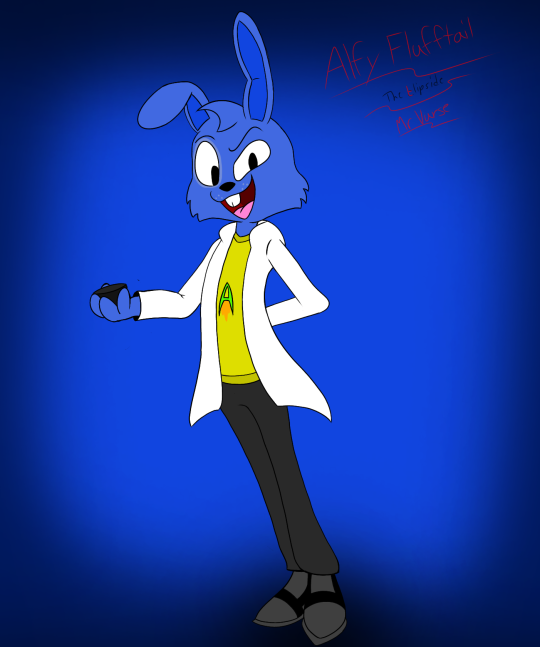
All "Trip To The Flipside" rights belong to ViolitKittin and art by Mr Vurse
Go subscribe to the official YouTube channel.
#Alfy Flufftail#Bunny#Fantasy#trip to the flipside#violitkittin#art#triptotheflipside#tttf#indie#2D#cartoon#mr vurse#furry#furry art#original#rabbit#youtube
3 notes
·
View notes
Text
Red-chestsd Flufftail, White-browed Purpletuft and Pringle’s Puffback are good cat names.



some puffy & fluffy names that make you go “yep he sure is that”
4K notes
·
View notes
Text
Round 3 - Reptilia - Gruiformes


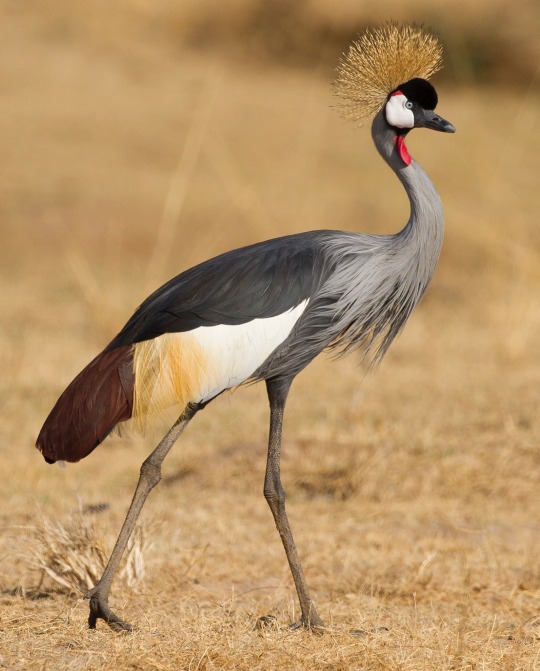

(Sources - 1, 2, 3, 4)
Our next order of birds are the Gruiformes, a diverse order with a widespread geographical diversity. “Gruiform” means “crane-like”, even though the majority of gruiformes are rails. Gruiformes contains the families Psophiidae (“trumpeters”), Aramidae (“Limpkin”), Gruidae (“cranes”), Rallidae (“rails”, “coots”, and “crakes”), Heliornithidae (“finfoots”), and Sarothruridae (“flufftails”).
Gruiformes are terrestrial or wading birds with a considerable amount of diversity. The Trumpeters (genus Psophia) (image 1) are rotund birds with long, flexible necks and legs, downward-curving bills, soft plumage, large eyes, and a “hunched” appearance. They are weak fliers but fast runners, and can also swim across rivers. The cranes (Gruidae) (image 3 and gif below) and the Limpkin (Aramus guarauna) are long-necked, long-legged, long-beaked waders, some of which are the world’s tallest flying birds. Their plumage varies by habitat. The Rallidae (image 4) are the most diverse family of Gruiformes. Many are associated with wetland habitats, some being semi-aquatic like waterfowl (such as the coot), and some being more like wading birds or shorebirds. The finfoots (Heliornithidae) resemble rails; they have long necks, slender bodies, broad tails, and sharp, pointed bills. Their legs and feet are brightly coloured and they are capable of walking well and even moving quickly on land. The flufftails (Sarothruridae) (image 2) are small- to medium-sized ground-living birds. Due to the diversity of this order, it is difficult to summarize them further!
Gruiformes evolved in the Paleocene, around 60 million years ago.
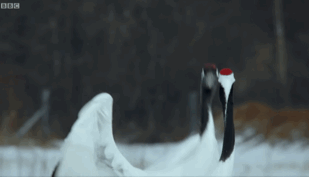
(source)
Propaganda under the cut:
Grey-winged Trumpeters (Psophia crepitans) are polyandrous and cooperative breeders. Up to three males mate with the dominant female of the flock, and all members of the flock contribute to raising the young.
One of the handful of non-avian dinosaurs we know the colors of is the Late Jurassic Caihong juji. Thanks to some exquisitely fossilized melanosomes (pigment cells) within the animals feathers, paleontologists were able to determine Caihong’s coloration by comparing it to those of living birds. The sheets of platelet-like melanosomes were solid and lacked air bubbles, and were thus most similar to the iridescent feathers that exist in modern Trumpeters (genus Psophia). It is thanks to trumpeters for preserving this type of melanosome, that we know the appearance of a dinosaur from the Late Jurassic!
The Limpkin (Aramus guarauna) has a beak that is slightly open near the end, giving it a tweezer-like action to remove their main prey, Apple Snails (family Ampullariidae), from their shells. In many individuals the tip of their beak curves slightly to the right, matching the Apple Snails’ shells.
Most species of cranes have been affected by human activities and are at the least classified as threatened, if not critically endangered. The plight of the Whooping Crane (Grus americana) of North America inspired some of the first US legislation to protect endangered species. After being pushed to the brink of extinction due to unregulated hunting and loss of habitat, just 21 wild (and two captive) Whooping Cranes remained by 1941. Thanks to conservation efforts, the total number of cranes in the surviving migratory population, including those in captivity, only slightly exceeds 911 birds as of 2020.
The Sanskrit epic poet Valmiki was inspired to write the first śloka couplet by the pathos of seeing a male Sarus Crane (Antigone antigone) shot while dancing with its mate.
The endangered South Island Takahē (Porphyrio hochstetteri) is a flightless swamphen indigenous to New Zealand. Takahē were hunted extensively by both early European settlers and Māori, and takahē's bones, as well as fossil remains, have been found in middens in the South Island. They were not named and described by Europeans until 1847, and then only from fossil bones. In 1850 a living bird was captured, and three more collected in the 19th century. After another bird was captured in 1898, and no more were to be found, the species was presumed extinct. Fifty years later, however, after a carefully planned search, South Island Takahē were dramatically rediscovered in November 1948 by Geoffrey Orbell in an isolated valley in the South Island's Murchison Mountains. Since then, takahē have been reintroduced to numerous locations across the country. As of 2023, the population is around 500 and is growing by 8% per year.
The Guam Rail (Hypotaenidia owstoni) came perilously close to extinction when Brown Tree Snakes (Boiga irregularis) were introduced to Guam, but some of the last remaining individuals were taken into captivity and have been breeding well. They have since been successfully introduced to the nearby Rota and Cocos islands, as the Brown Tree Snakes have yet to be eradicated in Guam. In 2019, the Guam Rail became the second bird species to be reclassified by the International Union for the Conservation of Nature from Extinct in the Wild, to Critically Endangered.
#sorry if there are any mistakes here and if it’s a bit short#it’s midnight and I’m fighting sleep to finish this#animal polls#round 3#reptilia#Gruiformes
83 notes
·
View notes
Note
Can I have a coy/meek werewolf regressor thing!!!
Coy/Shy Werewolf regressor theme !!!
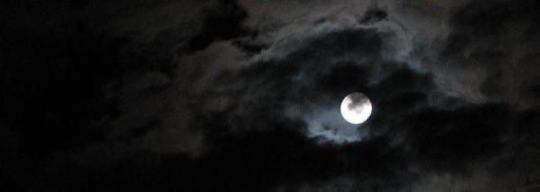
🌕 activities
Blanket fort building Howling softly into a pillow or pretending to “call the moon” Drawing your werewolf self with fluffy ears and tail Sniffing things for comfort (scratch-n-sniff stickers, scented playdough, etc.) Chewing (safe chewy toys or chew necklaces) for calming Listening to forest sounds, wind, and soft howls on loop “Pacing” or crawling on all fours for that little wolf energy Pretend play where you’re a baby wolf learning how to howl
🌕 clothes
Oversized hoodie or furry onesie (like a wolf, pup, or animal style) Pajamas with paw prints, moons, or star patterns Knee socks or mittens with paw designs Clip-on or headband wolf ears (gray, brown, black, or pastel!) DIY tail on your pants or belt loop (if you like) Lined slippers or soft paw-shaped socks blankie you carry like a cape to stay “hidden” when shy
🌕 toys
Plush wolves, dogs, foxes, or other woodland pals .Chewy toys or chewy necklaces (safe and soothing) Moon night light or galaxy projector Wolf pup-themed coloring books or storybooks Weighted plush or lap pad for grounded little wolfy naps Small squeaky toy for soft sound stims (if you like them)
🌕 games
“Learning to be a wolf” game – practice sniffing, howling, crawling “Tracking treats” – follow a trail of snack pieces around your room Pretend the full moon is coming and you have to prepare (gather stuffies, make a nest) “Pack naptime” – tuck in your plushies and nap beside them Stargazing or moon-watching (real or with projections) while wrapped in blankies (if watching from outside on a trampoline or concrete floor, make sure you're all comfy and cozy! You don;t want to accidentally fall asleep <3)
🌕 foods/drinks
Jerky or chewy fruit strips (gently gnawed, of course!) Soup in a spill-proof cup or thermos – warm and grounding Berries or berry-flavored yogurt (little forest treats) Milk or hot cocoa in a pup-safe cup Meatballs, mini sausages, or soft protein bites Goldfish crackers (do wolves eat fish?) or paw-shaped gummies
🌕 nicknames <3
Lil' wolfie shy little wolf lil pup lil fang soft fang soft pup growlie shyfang barklet howlet flufftail little wolf baby
#agere blog#sfw agere#sfw little blog#sfw littlespace#petre#sfw interaction only#sfw#agere#pet regressor#petre blog#werewolf#lycanthrope#werewolves#lycan#monster#lycanre#werewolf regressor#regressor#age regressor#puppy regressor#baby regressor#pet regression#petre community#sfw petre#agere positivity#agere activities#wolfre#wolf regression#wolf regressor#shy regressor
47 notes
·
View notes
Note
I once said to myself: “𝐢𝐟 𝐚𝐧 𝐚𝐫𝐭𝐢𝐬𝐭 𝐛𝐞𝐥𝐢𝐞𝐯𝐞𝐬 𝐭𝐡𝐚𝐭 𝐭𝐡𝐞 𝐝𝐞𝐯𝐞𝐥𝐨𝐩𝐞𝐫𝐬 𝐦𝐚𝐝𝐞 𝐚 𝐦𝐢𝐬𝐭𝐚𝐤𝐞, 𝐡𝐞 𝐡𝐚𝐬 𝐭𝐡𝐞 𝐫𝐢𝐠𝐡𝐭 𝐚𝐧𝐝 𝐭𝐡𝐞 𝐨𝐛𝐥𝐢𝐠𝐚𝐭𝐢𝐨𝐧 𝐭𝐨 𝐜𝐨𝐫𝐫𝐞𝐜𝐭 𝐭𝐡𝐢𝐬 𝐦𝐢𝐬𝐭𝐚𝐤𝐞 𝐭𝐡𝐚𝐭 𝐭𝐡𝐞𝐲 𝐦𝐚𝐝𝐞”.
So I redrawn several pics I came across from rottmnt (I made April's flufftails larger, her chin sharper and her breast more noticeable. And in one pic I made an attempt to color the eyes).
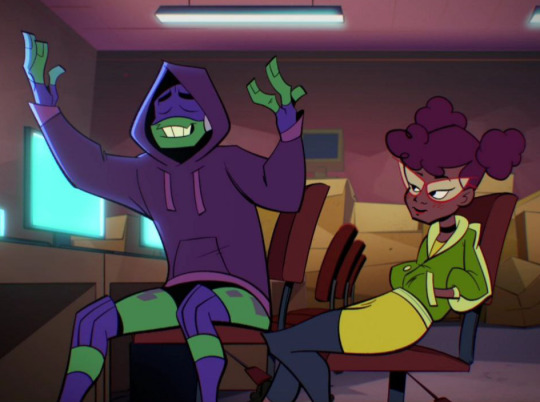

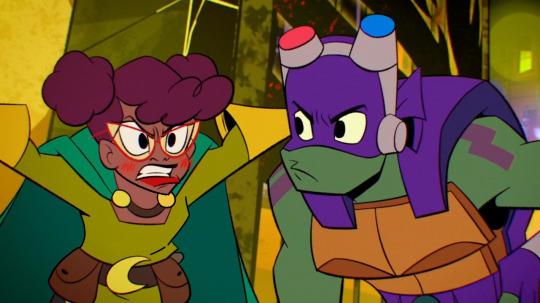


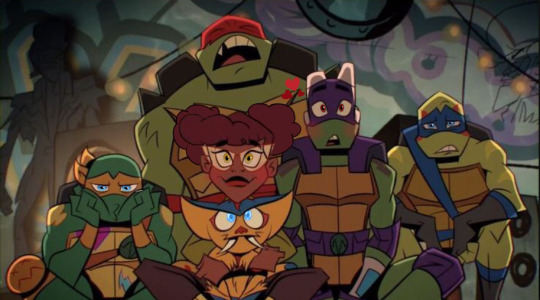
What do you think about my works?🤗💖💜💞
Girlie....THESE ARE AWESOMEEE~!!!!💕💕💖💖💯💯💯 (sorry, I am a bit late to answer cuz I am feeling a lil bit under the weather😅)

You did a great job!💕💕💖💕💖

#rottmnt#rise donatello#rise donnie#rise apritello#rise april#inspiredwriter#cuteness overload#adorable#teenage mutant ninja turtles#april o'neil#tmnt donatello#tmnt apritello#apritello#apriltello#donatello hamato#tmnt donnie#tmnt april
46 notes
·
View notes
Note
hi I just wanted to say i really love seeing all the critters you guys post here, it makes my day :)
do you have any cute flufftails (sarothruridae)? i love those guys soooo much and i want others to see them too
Why thank you kumquat!
Here are a couple of flufftail friends who have been waiting here for you all this time...

Buff-spotted Flufftail (Sarothrura elegans), family Sarothruridae, order Gruiformes, Kakamega Forest NR, Rondo Retreat Centre, Kenya
Photograph by Tong Mu

Buff-spotted Flufftail (Sarothrura elegans), family Sarothruridae, order Gruiformes, found across much of Sub-Saharan Africa
Photograph by Hugh Chittenden
412 notes
·
View notes
Text

Taking in a charge for the next turn...
Robo comm for Flufftail!
93 notes
·
View notes
Text
Intro post!!
”Hm? Oh, hello there traveler…”
[uhhhhh hi! This used to be a private shitposting blog but I’m turning it into an askblog :3]
Main OCs:
Queen Sky- My sona! Any pronouns genderfluid asexual shapeshifter, Lord of cats
Tree of Cinder- They/Them non binary bisexual cat, a groupless healer
Flufftail- She/Hear aroace cat who’s fluffy, a light seeker for the Tribe of the beach
More info about them:
Sky~
Has adhd and autism
Doesn’t know the difference between a crocodile and alligator
Kind of childish
Cares about her kingdom
Loves cats
Just goop
can see people’s loved ones
can’t do a masculine voice for the life of her
disguises herself as people’s loved ones to hunt and eat them but doesn’t do that often
sucks at hunting the way shapeshifters do it
likes using neoprouns
loud
Afab
“How xe would talk!”
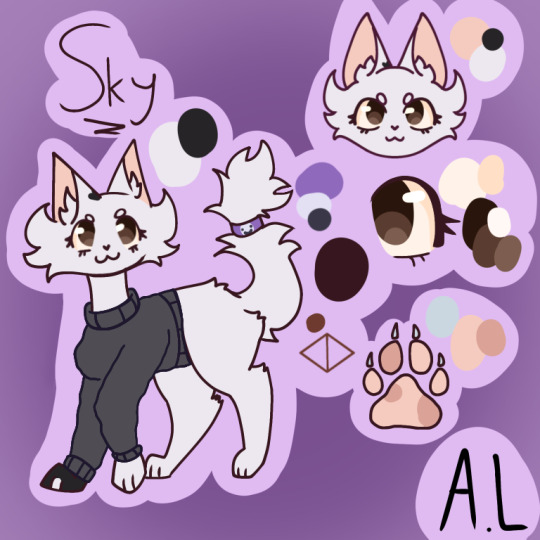
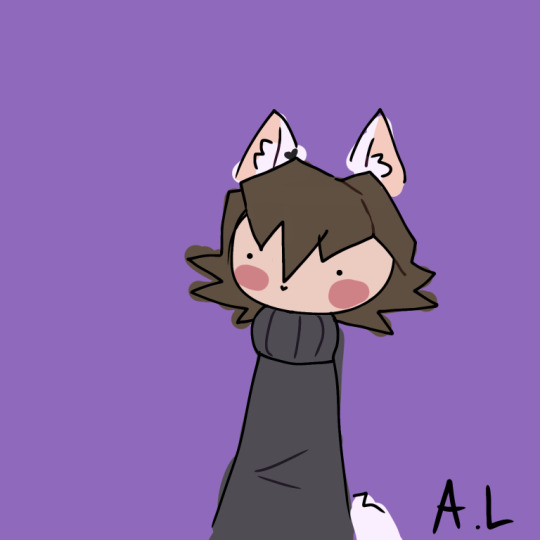
Tree of Cinder~
Lives in a den
really likes herbs
Good kitten sitter
sucks at fighting
very good at healing
Trying to help Sky
called Treecinder
used to be in a group
a wanderer
takes care of hurt people when they find them
visits the kingdom from time to time
socially awkward
hyper fixated on the tribes
Amab
“How they will talk”

Mallow~(GOING TO BE REDESIGN)
VERY old(in her 50s)
daughter of the tribe leader
no mother
female
Southern grandma coded
loves Sky as a grandchild
loves Treecinder as her adult child
snarky
will teach the young of the tribe about it
“How she will talk.”

[How mod will talk]
Rules:
No nsfw(suggestive asks about Treecinder and Fluffy is allowed but don’t be weird with sky…-)
Don’t try to harm my OCs!
don’t mention anything triggering!
don’t be disrespectful!
be patient!
magic anons are allowed just don’t be weird.
That’s all!
#askblog#ask blog#oc ask blog#kottyoverse#furry sfw#sfw furry#sfw interaction only#my ocs#anti ai art#ocs#oc stuff#my ocs <3#original character#my oc art#my characters#oc art#artwork#art#artists on tumblr#character art#digital art#digital artist#digital artwork#furry art#ibispaint art#my art#my artwork#small artist#illustration#drawings
11 notes
·
View notes
Note
My warrior name predictions for this arc’s kits and apprentices:
• Goldenpaw will be Goldenheart, Goldenshine, Goldensong, or Goldenpelt.
• Shinepaw will be Shinepool, Shineheart, Shinefeather, or Shineclaw.
• Moonpaw will be Moonbeam, Moonface, or Moonspirit.
• Sunkit will be Sunbright, Sunflight, Sunpelt, Sunfur, or Sunleap.
• Hazelkit will be Hazelblossom, Hazelbloom, Hazelflower, Hazelbranch, Hazelbark, or Hazelfall. I really like the -blossom suffix if it’ll be used to honor Blossomfall.
• Oakkit will be Oakflower, Oakbloom, Oakfrost, Oakshade, or Oakfall.
• Redpaw will be Redwing, Redpelt, Redfur, Redfoot, Redtooth, or Redfang.
• Sprucepaw will be Sprucefrost, Sprucebark, Sprucefall, Spruceleap, Spruceclaw, or Spruceleaf.
• Quickkit will be Quickfire, Quickfoot, or Quickstrike. I love the idea of him being named after his dad.
• Poolkit will be Poolfrost, Poolshine, Poolwing, Poolfeather, or Poolsplash.
• Beechkit will be Beechfall, Beechtail, Beechfoot, Beechwhisker, Beechlight, or Beechstripe.
• Robinpaw will be Robinfeather, Robinflight, Robinclaw, Robinstorm, or Robinwing, fifth of her name.
• Starlingpaw will be Starlingflight, Starlingheart, or Starlingsong. I hope he’s given the -heart suffix for the same reason as Lilyheart was given her’s; to honor a dead parent.
• Eelkit will be Eelsplash, Eeltail, Eelflight, Eelglow (if the name is based off of an electric eel), or Eelstrike. I’d also really like him to be a medicine cat, RiverClan hasn’t had a male medicine cat since Mudfur. If he’s indeed Graysky’s son, this means this’ll be the first time a RiverClan medicine cat has mentored their kin.
• Heronkit will be Heronshine, Heronfeather, Heronflight, Heronwing, Heronpool, or Heronmist. I can definitely envision -shine, -pool, or -mist being based off of her silver pelt.
• Silkypaw will be Silkypelt, Silkyfur, Silkysong, Silkylight, Silkyglow, or Silkyfeather.
• Fluffpaw will be Fluffpelt, Fluffwing, Fluffbreeze, or Flufftail.
• Rustlekit will be Rustletail, Rustlebush, Rustleleaf, or Rustlebreeze.
• Stretchkit will be Stretchclaw, Stretchtalon, Stretchtail, or Stretchfang.
These are all so good, I do think and really hope these are likely.
Lowkey hope they give us a fifth Robinwing then have her move to ShadowClan, so at long last we can have a Robinwing from each clan.
Eelkit becoming a medicine cat would be so cool, it’s wild that there hasn’t been a male medicine cat there for that long.
12 notes
·
View notes
Photo
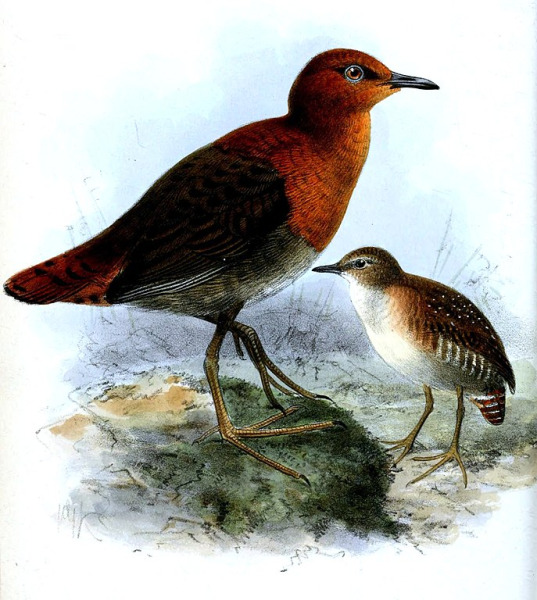
A new variant has been added!
Slender-billed Flufftail (Sarothrura watersi) © John Gerrard Keulemans
It hatches from adjacent, brown, common, dark, earthy, eastern, female, few, green, high, male, much, odd, olive, rare, rich, slender, and tiny eggs.
squawkoverflow - the ultimate bird collecting game 🥚 hatch ❤️ collect 🤝 connect
7 notes
·
View notes
Text
Fossil Novembirb 15: Oasis in the Desert
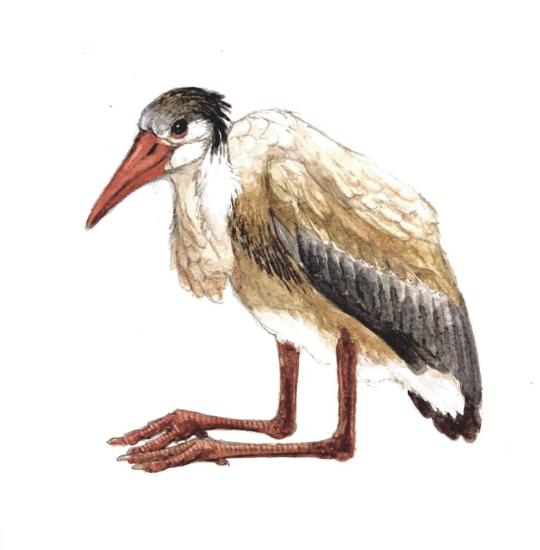
Xenerodiops by @iguanodont
We FINALLY get to an ecosystem that isn't in Europe, North America, Antarctica, or Oceania - it's Jebel Qatrani Time!
(If you are as appalled as I am at the low sampling rates of fossil localities in Asia, South America, and Africa, welcome to the club, and support paleontologists who are from and work in countries from those continents!!!)
The Jebel Qatrani Formation is an ecosystem from Egypt at the end of the Eocene through the early Oligocene. It showcases the tropical forests, swamps, and marshes that existed at this time, emptying into the Tethys Sea. A wet and humid environment, it would have been a weird mixed ecosystem, with both the old and the new coexisting on the riverbanks. And, like in the forests and plains of Oligocene Europe, we see many modern bird groups show up for the first time here - and also very similar to their living relatives! This is a departure from the mammals in the region, which were unique and weird for the time period (though early members of modern groups are found here, too).
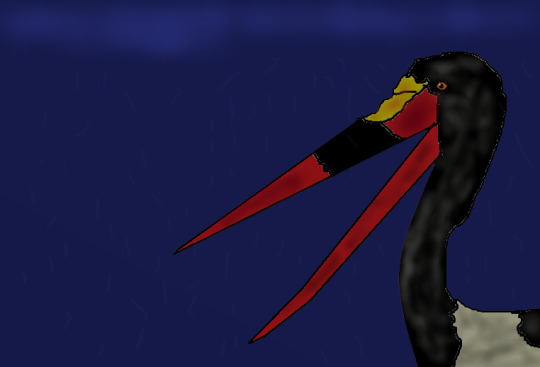
Palaeoephippiorhynchus by Bubblesorg
Being a wetland and humid environment, the main feature of the avifauna here are aquatic birds - many of which have close relatives today. Palaeoephippiorhynchus is the oldest known fossil stork, and was remarkably similar to the living Saddle-Billed Stork - even having the same upcurved bill. While it's uncertain if they're close relatives or not, it is possible that living Saddle-Bills are similar to this ancient form. There was also a mid-sized heron, a bird extremely similar to living Black-Crowned Night Herons, and Xenerodiops - a heron with a pointed and strong bill, curved downward - good for grabbing onto prey. It was a very sturdy, robust bird - even for a heron.
In addition, there was Goliathia - the fossil Shoebill! This bird had legs much like the living shoebill, and was similar enough in the limbs that it might be in the same genus! It probably lived very similarly to living shoebills, feeding on fish in the wetlands around it. What its beak would have looked like is uncertain - the closest living relative to the Shoebill is the Hammerkop, which has a very different skull. What their ancestral skull was, or what Goliathia's was, remains a mystery.

Goliathia by Antonio Rares Mihaila
But if you think I'm done with the water birds, you're very wrong - this is just the beginning! There was also an indeterminant cormorant, which had a very hooked and tapered beak; birds similar to living crowned cranes and others like living flufftails; early jacanas like Janipes which was bigger than all living jacanas but still had the large feet for floating on vegetation, showcasing the vegetation in these wetlands was sturdy enough to hold it up; other early jacanas smaller in size as well like Nupharanassa; and of course -
The Flamingos! Well, yes and no. There was an indeterminate crown-flamingo (ie in the group that all living flamingos are in), a bit bigger than a living lesser flamingo. But there was also Palaelodus - one of the "Grebe-Flamingos" or "Swimming-Flamingos", a long-lasting group of birds that first appear in the early Oligocene and lasted until possibly the Pleistocene! They looked superficially similar to living flamingos and were more closely related to them than to grebes, but they did have some similar characteristics to grebes as well - specifically having less of a kink in the neck, shorter lower legs, and flatter limb bones like those in grebes. They also had webbed feet, which would have allowed for diving or swimming. It also had a straight, conical bill, very unlike the bill of living flamingos.
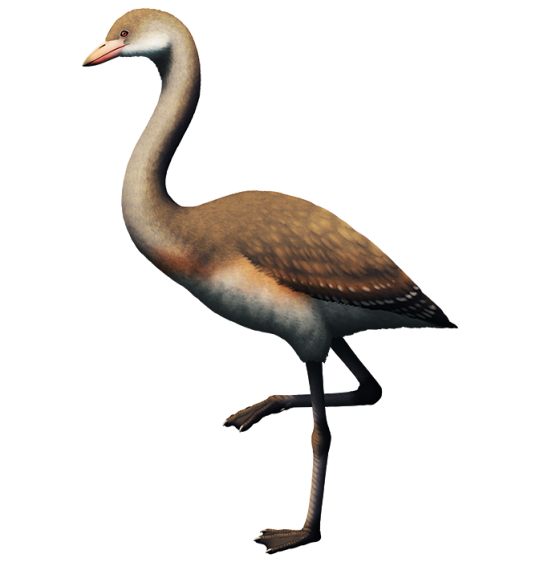
Palaelodus by @alphynix
There were also perching birds, such as an early turaco very similar to the living genus Crinifer; and early eagles, ospreys, and other birds of prey that haven't really been named - mainly because they are very similar to living species, but so distant in time it seems unlikely they'd be in the same genus still... right? One, very similar to the living sea eagle, was found near the shore - indicating a similar ecology to its living relative. Another was almost identical to the living osprey, just smaller in size. And another was similar in size to living ospreys, but more robust than them. This place was filled with raptors!
Of course, I can't ignore the metaphorical elephant in the room. One of the most mysterious birds of the Jebel Qatrani is Eremopezus, a bird that has similarities to so many different groups of birds that its exact position is still a mystery. At this time it is thought to be a Palaeognath, possibly closely related to ostriches or maybe elephant birds - as the volant Lithornithids start to disappear, ratite-like Palaeognaths become more and more common. It was flightless, and probably lived similarly to modern ostriches and other ratites - as a a large herbivore, probably taking advantage of the wetland landscape and the abundance of food.

Eremopezus by @thewoodparable
Jebel Qatrani is such an important formation because it sheds light on the evolution of even more bird groups than those we see in former Laurasia (North America + Eurasia). And it is possible that many lineages we still have in Africa today have been around for thirty million years - and may have been very similar in ecology and appearance during that whole time. Given living birds react to changing climates by shifting with the ecosystems, it's possible that these lines of birds similarly followed the migration of wetlands and other habitats during the climate change to come, persisting to this day across the continent.
Sources:
Kampouridis, P., J. Hartung, F. J. Augustin. 2023. The Eocene-Oligocene Vertebrate Assemblages of the Fayum Depression, Egypt. The Phanerozoic Geology and Natural Resources of Egypt. Advances in Science, Technology, & Innovation. 373-405.
Mayr, 2022. Paleogene Fossil Birds, 2nd Edition. Springer Cham.
Mayr, 2017. Avian Evolution: The Fossil Record of Birds and its Paleobiological Significance (TOPA Topics in Paleobiology). Wiley Blackwell.
Rasmussen, D. T., S. L. Olson, E. L. Simons. 1987. Fossil birds from the Oligocene Jebel Qatrani formation Fayum Province, Egypt. Smithsonian Contributions to Paleobiology 62(62): 1-20.
71 notes
·
View notes
Note
Hello!
May I request 4 random Felines? I'd love to design a few! :D
Thank you if you can!




yeah !! the felines of my choice are silky rowler #34, mainely flufftail #79, cat #960, and leopard #2428 :o)
119 notes
·
View notes